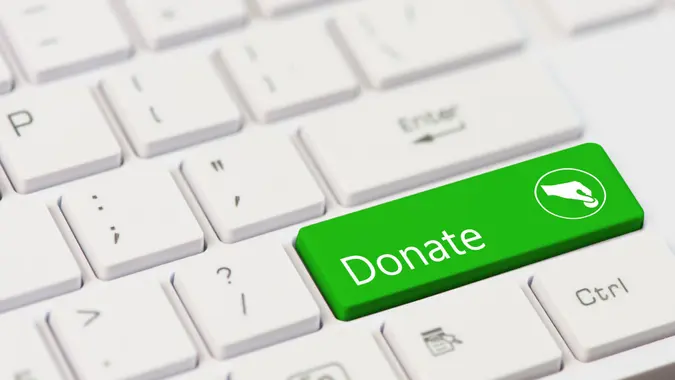Advertiser Disclosure
GOBankingRates works with many financial advertisers to showcase their products and services to our audiences. These brands compensate us to advertise their products in ads across our site. This compensation may impact how and where products appear on this site. We are not a comparison-tool and these offers do not represent all available deposit, investment, loan or credit products.
5 Kinds of Financial Stimulus You Already Get Without Even Knowing It
 Written by
Heather Taylor
Written by
Heather Taylor
 Edited by
Chris Cluff
Edited by
Chris Cluff

Commitment to Our Readers
GOBankingRates' editorial team is committed to bringing you unbiased reviews and information. We use data-driven methodologies to evaluate financial products and services - our reviews and ratings are not influenced by advertisers. You can read more about our editorial guidelines and our products and services review methodology.

20 YearsHelping You Live Richer

Reviewed by Experts

Trusted by Millions of Readers
It may not be a one-time check, but Americans have more opportunities to access financial stimulus than they may realize. From tax-based stimulus to reduce your taxable income to programs that help pay bills for expensive heating and cooling costs, chances are good you will bookmark these available resources after reading this article.
Find Out: Fidelity Says This Is a Surprising Risk of Holding Too Much Cash — Do You Have Too Much?
Explore More: 6 Low-Risk Ways To Build Your Savings in 2025
GOBankingRates spoke to Eric M. Steffy, founder and CEO at Federal Solutions Support, to find out which known and lesser-known resources are worth taking advantage of for a financial boost. You may be eligible for one (or more) of these stimulus programs.
Tax-Based Stimulus Payments
You might be able to receive various tax credits and tax breaks. The standard deduction doesn’t require filing any additional forms and automatically reduces your taxable income.
Steffy recommends looking into the earned income tax credit (EIC), child tax credit, American Opportunity & Lifetime Learning Credits and the Saver’s Credit. These refundable programs need to be applied for and may or may not be applicable to your financial circumstances, but they can make a difference for your bank account — even if you don’t owe anything in taxes. For example, if you made eligible contributions to your retirement plan, you might be able to take a tax credit through the Saver’s Credit.
Consumer Subsidies
There are several types of resources that help reduce the cost of groceries, internet and phone services. The Supplemental Nutrition Assistance Program (SNAP), provides food benefits to lower-income families while WIC provides women, infants and children with healthy foods, nutrition education and counseling at no cost. For those with children attending school, Steffy said the School Meal Program makes free or low-cost lunches available to children.
If you’re having a hard time managing your phone and/or internet bills, Steffy recommends looking into the Affordable Connectivity Program and Lifeline.
“These are federal programs that offer discounts of up to $9.95 a month, to help low-income households afford internet and phone services needed for work, school and healthcare.”
FERS Special Retirement Supplement
Certain federal employees may qualify for the FERS Special Retirement Supplement. According to Steffy, this financial bridge provides income until a retiree can start collecting Social Security benefits.
“Federal employees also receive an extra life insurance benefit, at no cost, before age 35 under the FEGLI plan,” he said. “Additionally, paid leave accruals (vacation and sick leave) have a real cash value if carried over to separation.”
Energy and Housing Assistance Programs
You may be eligible for energy and housing assistance programs. If you itemize your taxes, Steffy said you can take the mortgage interest deduction. Your state of residence may also offer property tax relief programs to seniors, veterans and those receiving disability care.
Need help paying with high heating and cooling bills? Look into the Low-Income Home Energy Assistance Program (LIHEAP). Another resource worth applying for is the Weatherization Assistance Program. This program offers free home improvements to eligible households to lower utility costs. According to the U.S. Department of Energy, households save an average of $372 or more annually through weatherization improvements.
Health Insurance Premium Contributions
You’re doing more than buying benefits when you pay for your health insurance premiums, 401(k), health savings account (HSA), flexible savings account (FSA) and thrift savings plan (TSP) contributions. You’re lowering your taxable income at the same time.
“When money is deducted from your paycheck to invest in health benefits or retirement, this investment comes from your pre-tax pay before federal income tax is calculated,” Steffy said.
Steffy uses the example of an HSA that gives you an immediate tax deduction, allows for tax-free growth and lets you make a tax-free withdrawal of this money for qualifying expenses.
“If you earn $85,000 and are in the 22% federal tax bracket and make an HSA contribution of $9,550, you’ll save $2,101 in federal taxes and $1,200 in FICA and state taxes,” Steffy explained. “That’s a hidden stimulus payment to you of over $3,000.”
More From GOBankingRates
Share This Article:




You May Also Like


I Asked ChatGPT What the Richest Americans Invest In -- Here's the Surprising List
December 24, 2025
4 min Read

3 Tools the Wealthiest Americans Use To Safeguard Their Generational Wealth
December 23, 2025
4 min Read





Only 50% of Salary Raise Requests Succeed -- 6 Proven Strategies To Boost Your Chances
December 22, 2025
4 min Read

10 Tips To Start a Business With Very Little Money, According to Entrepreneurs
December 23, 2025
4 min Read


This Is What You Have To Do If You Want To Win With Money, According to a Ramsey Expert
December 23, 2025
4 min Read

The 7 Cheapest States for a Million-Dollar Lifestyle (That Aren't Florida or Texas)
December 23, 2025
4 min Read

Barbara Corcoran's Most Outdated Piece of Advice (But Can It Still Work?)
December 23, 2025
4 min Read

The End-of-Year Money Checklist Every Middle-Class Family Should Do, According to a Financial Planner
December 23, 2025
4 min Read

Why Do Shriners and Other Charities Ask You To Give Exactly $19 a Month?
December 22, 2025
4 min Read
Questions Around The Economy
Make your money work for you
Get the latest news on investing, money, and more with our free newsletter.
By subscribing, you agree to our Terms of Use and Privacy Policy. Unsubscribe at any time.


Thanks!
You're now subscribed to our newsletter.
Check your inbox for more details.



Sending you timely financial stories that you can bank on.
Sign up for our daily newsletter for the latest financial news and trending topics.
For our full Privacy Policy, click here.
Looks like you're using an adblocker
Please disable your adblocker to enjoy the optimal web experience and access the quality content you appreciate from GOBankingRates.
- AdBlock / uBlock / Brave
- Click the ad blocker extension icon to the right of the address bar
- Disable on this site
- Refresh the page
- Firefox / Edge / DuckDuckGo
- Click on the icon to the left of the address bar
- Disable Tracking Protection
- Refresh the page
- Ghostery
- Click the blue ghost icon to the right of the address bar
- Disable Ad-Blocking, Anti-Tracking, and Never-Consent
- Refresh the page



